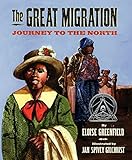The Solution to Reading Comprehension
Lessons & Units :: The Great Migration: Journey to the North 4th Grade Unit
Paired Text Questions: "Slavery in the North" and The Great Migration: Journey to the North
Lesson Plan
The Great Migration: Journey to the North | 730L

- Learning Goal
- Integrate information from the non-fiction passage “Slavery in the North” and the book The Great Migration: Journey to the North to write or speak more knowledgeably about hardships faced by African Americans in the 19th and 20th centuries.
- Necessary Materials
- Provided:
- Questions
- Non-fiction reading passage “Slavery in the North”
Not Provided:
The Great Migration: Journey to the North
- Questions 1 and 2 refer to the non-fiction passage “Slavery in the North.” Questions 3 and 4 refer to the book The Great Migration: Journey to the North. Questions 5 and 6 refer to both the passage and the book.
- Student versions of the questions are in the 'Texts & Materials' tab.
Part 1: “Slavery in the North”
Read the passage “Slavery in the North” out loud to your students. Alternatively, students can read the passage independently or as a group.
Question 1: What were some of the hardships, or difficulties, facing African Americans in the nineteenth century? Give two examples from the passage.
Sample student answer:
- African Americans were used as slaves in the South and the North.
- Families of African Americans were sometimes split apart when children were sold away.
Question 2: What did African Americans do in response to these hardships? Use information from the passage to support your answer.
Sample student answer (may vary):
- Some African Americans, like Sojourner Truth, became abolitionists.
- Some African Americans, like Sojourner Truth’s mother, cried.
Part 2: The Great Migration: Journey to the North
Question 3: What were some of the hardships facing African Americans in The Great Migration: Journey to the North? Give two examples from the book.
Sample student answer (answers may vary but should all correspond to the book):
- African Americans worked all day for almost no pay.
- Signs told African Americans where to go and what to do.
- African Americans couldn't find enough work.
Question 4: What did African Americans do in response to these hardships? Use information from the book to support your answer.
Sample student answer (answers may vary but should resemble the following): Many African Americans moved north for work and a better life. They went to cities like Chicago, New York, Philadelphia, and Washington, D.C.
Part 3: “Slavery in the North” and The Great Migration: Journey to the North
Question 5: How were the hardships facing African Americans in the 19th century and in the 20th century alike?
Sample student answer: Answers may vary:
- African Americans faced discrimination in both centuries.
- African Americans were forced to move long distances in both centuries.
Question 6: In “Slavery in the North,” Professor Alan Singer says that the effects of slavery linger, or remain, through discrimination. What is an example of discrimination in The Great Migration: Journey to the North that could be an effect of slavery?
Sample student answer: Responses may vary, as long as they have a basis in the book. Students may point out such examples as the signs telling African Americans where to go and what to do, and the burning of schools and homes by the Ku Klux Klan.
Texts & Materials
Standards Alignment
(To see all of the ReadWorks lessons aligned to your standards, click here.)



I love this activity. I used it to implement a close reading activity for my fourth grade students. They really seemed to love it and they were engage through the entire process. I was really happy to see how discussing slavery in the North and South promoted a more rigorous learning experience for my students. This was an excellent activity and I plan to use it again in the future.
Anonymous
These lesson plans are good.